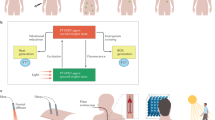Abstract
5-Aminolaevulinic acid (ALA)-induced prophyrin photosensitisation is an attractive option for photodynamic therapy (PDT) since skin photosensitivity is limited to 1-2 days. However, early clinical results on colon tumours using the maximum tolerated oral dose of 60 mg kg-1 showed only superficial necrosis, presumably owing to insufficient intratumoral porphyrin levels, although inadequate light dosimetry may also be a factor. We undertook experiments using ALA, 25-400 mg kg-1 intravenously, to establish the threshold doses required for a PDT effect. Laser light at 630 nm (100 mW, 10-200 J) was delivered to a single site in the colon of photosensitised normal Wistar rats at laparotomy. The animals were killed 3 days later and the area of PDT-induced necrosis measured. No lesion was seen with 25 mg kg-1. The lesion size increased with larger ALA doses and with the light dose but little benefit was seen from increasing the ALA dose above 200 mg kg-1 or the light dose above 100 J. Thus there is a fairly narrow window for optimum doses of drug and light. Further experiments showed that the PDT effect can be markedly enhanced by fractionating the light dose. A series of animals was sensitized with 200 mg kg-1 ALA and then treated with 25 J. With continuous irradiation, the lesion area was 13 mm2, but with a single interruption of 150 s the area rose to 94 mm2 with the same total energy. Results were basically similar for different intervals between fractions (10-900 s) and different numbers of fractions (2-25). This suggests that a single short interruption in the light irradiation may dramatically reduce the net light dose required to achieve extensive necrosis.
This is a preview of subscription content, access via your institution
Access options
Subscribe to this journal
Receive 24 print issues and online access
$259.00 per year
only $10.79 per issue
Buy this article
- Purchase on Springer Link
- Instant access to full article PDF
Prices may be subject to local taxes which are calculated during checkout
Similar content being viewed by others
Author information
Authors and Affiliations
Rights and permissions
About this article
Cite this article
Messmann, H., Mlkvy, P., Buonaccorsi, G. et al. Enhancement of photodynamic therapy with 5-aminolaevulinic acid-induced porphyrin photosensitisation in normal rat colon by threshold and light fractionation studies. Br J Cancer 72, 589–594 (1995). https://doi.org/10.1038/bjc.1995.378
Issue Date:
DOI: https://doi.org/10.1038/bjc.1995.378
This article is cited by
-
Effect of an oxygen pressure injection (OPI) device on the oxygen saturation of patients during dermatological methyl aminolevulinate photodynamic therapy
Lasers in Medical Science (2013)
-
Enhancement of methyl-aminolevulinate photodynamic therapy by iron chelation with CP94: an in vitro investigation and clinical dose-escalating safety study for the treatment of nodular basal cell carcinoma
Journal of Cancer Research and Clinical Oncology (2008)
-
Möglichkeiten und Grenzen der Fluoreszenzdiagnostik und photodynamischen Therapie
HNO (2004)
-
Effects of light fractionation and different fluence rates on photodynamic therapy with 5-aminolaevulinic acid in vivo
British Journal of Cancer (2003)
-
Photodynamic therapy for cancer
Nature Reviews Cancer (2003)



